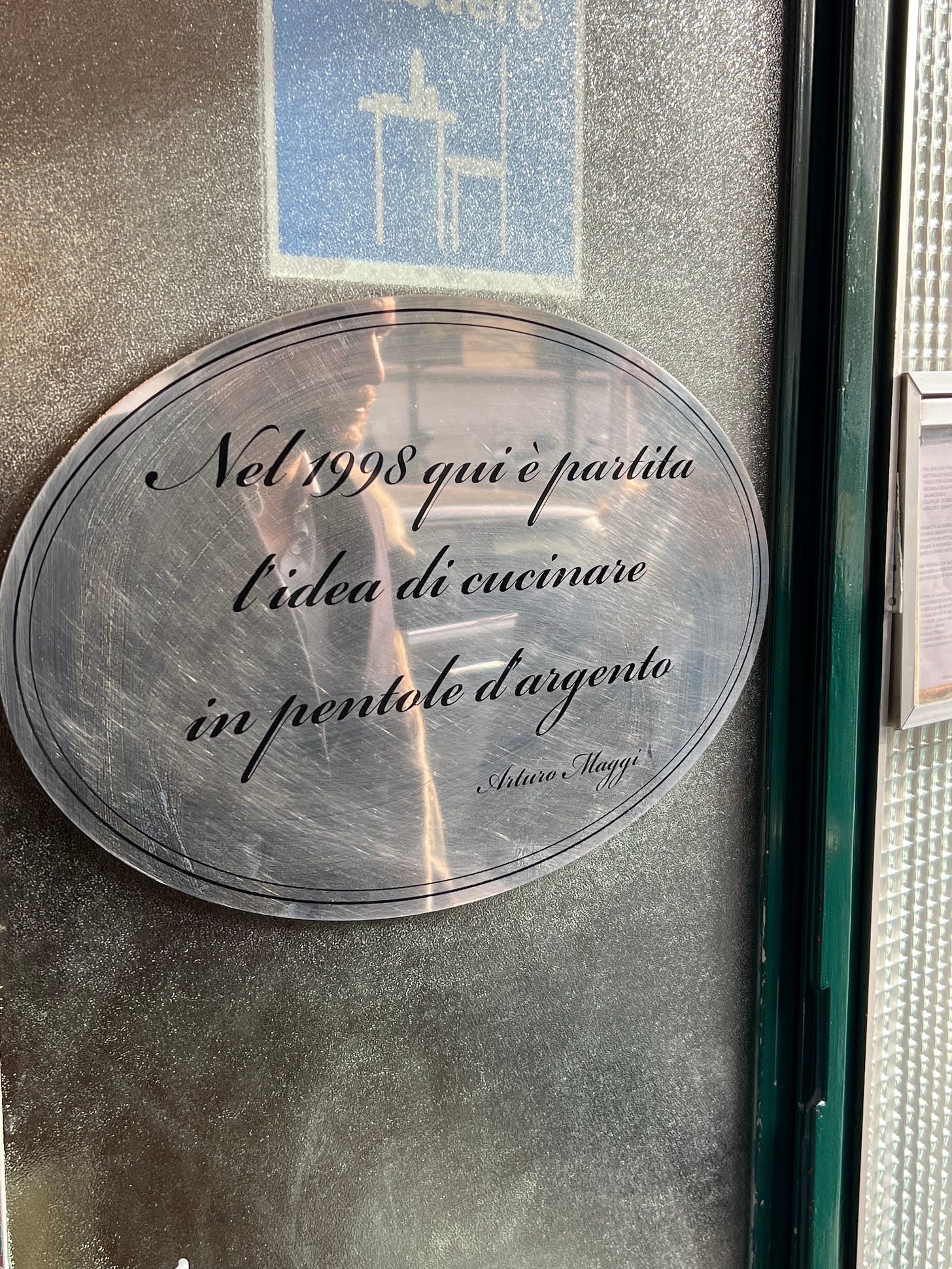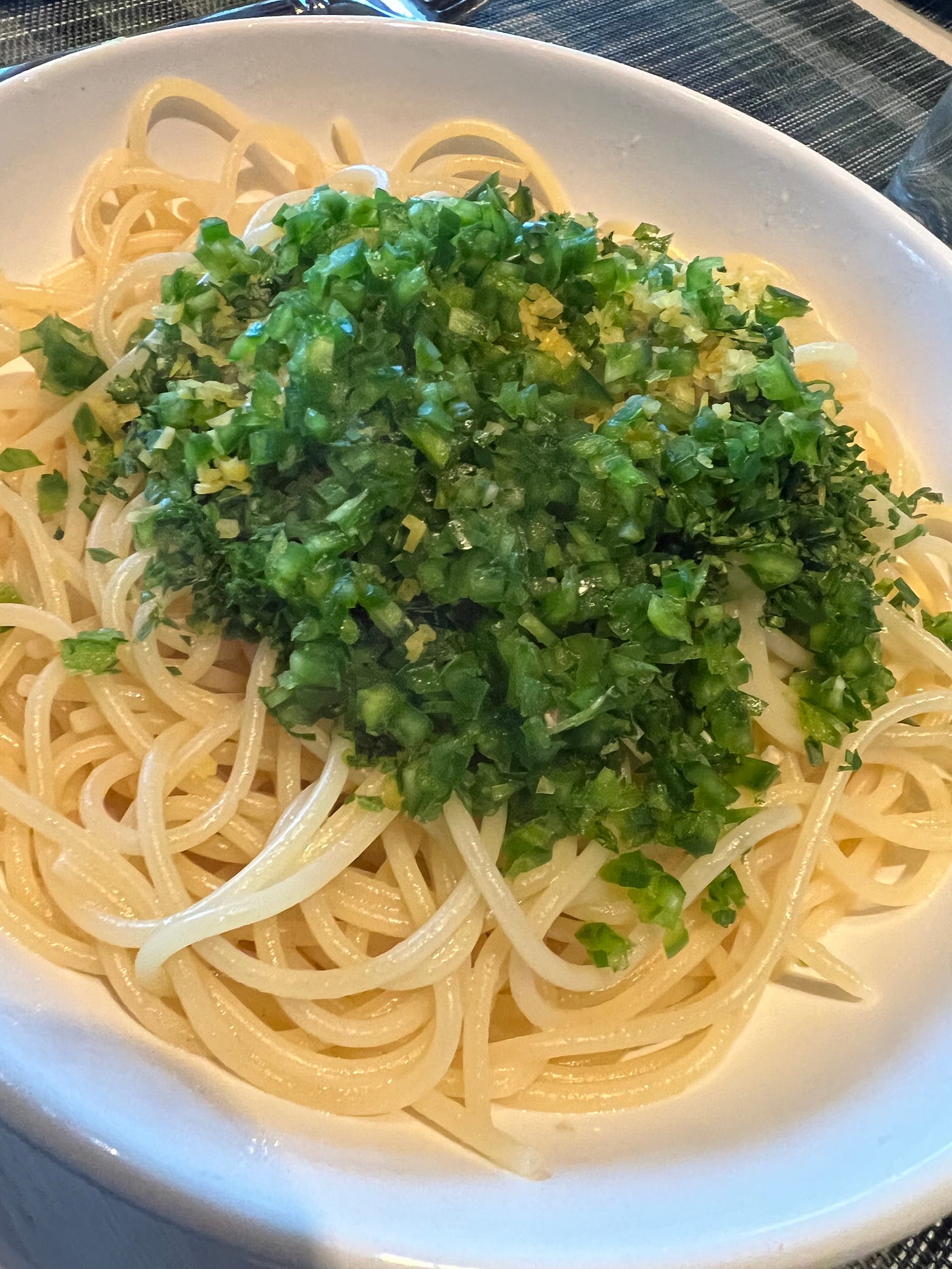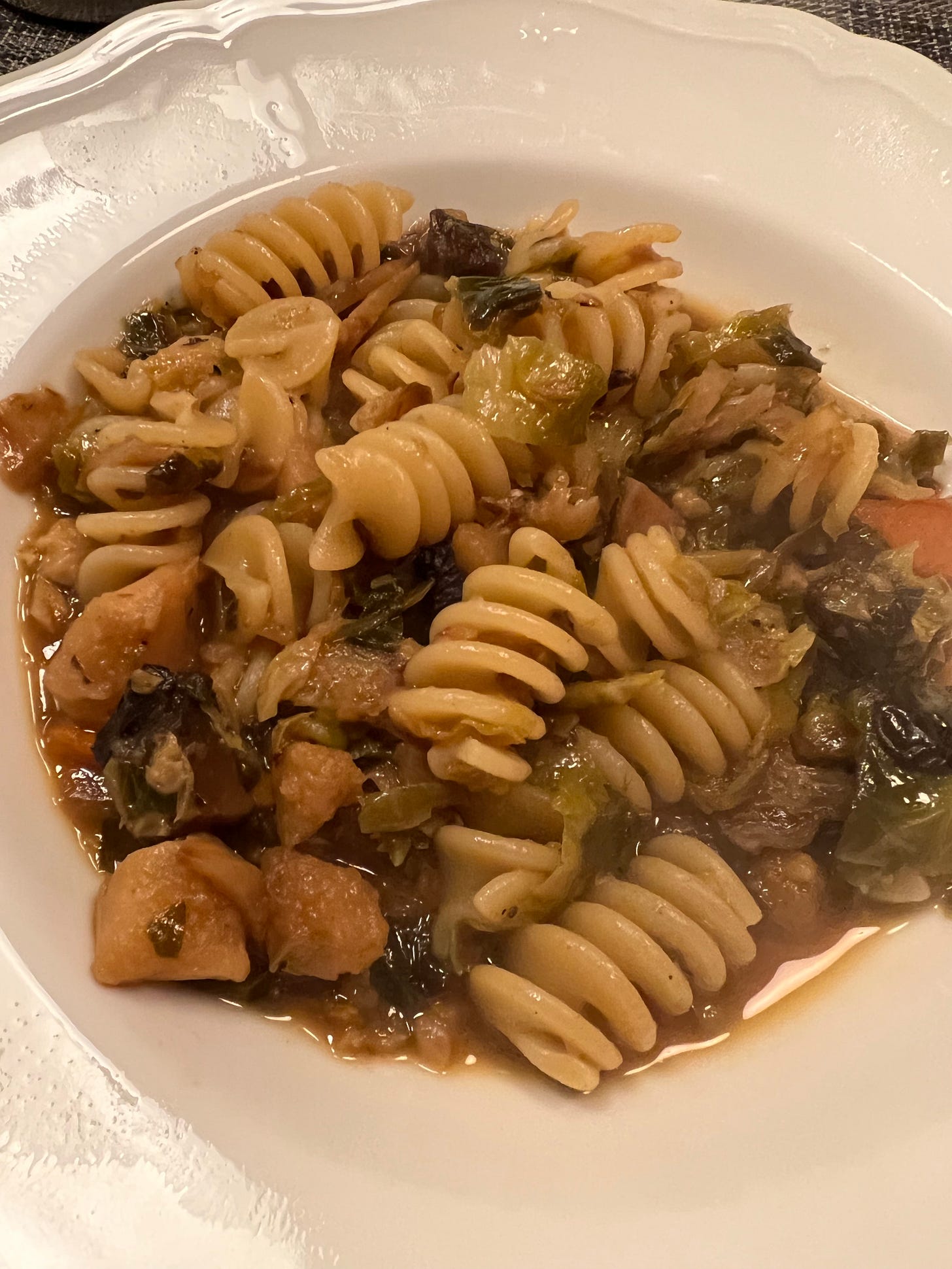The Favorite: Latteria San Marco
Thoughts on What Makes a Favorite Restaurant, A Few of My Contenders, Re-valuing Eating Out, A Simple Signature Pasta, Plus a Great Use for Some Leftovers
Issue #32 is here, the last of 2021. Seems hard to believe 2021 is over, just as it is hard to believe we are locking ourselves down again (because no one else seems to want to do it). I hope you have managed to enjoy the holidays and are looking forward to the new year. May it be full of love from family and friends, to whom I hope you will serve delicious things you cook yourself. —Mitchell
Having spent my entire career in food, I’m regularly asked whether I have a favorite restaurant. I usually say no, that it depends on the situation, on my cravings, that I need to know where I am, who I am with, what my budget is. The truth is that when you are supposed to stay current on everything that’s going on in the restaurant world, you don’t have much opportunity to go back to the same places more than once. There are always new restaurants to try, especially in New York, where I live, and where I am always torn between cooking at home and going out. For decades I’ve kept a running list of new restaurants. Sadly, it’s not uncommon for some to go out of business before I manage to get to them.
Rarely can a restaurant become a favorite after only one visit. Making such a determination even after a few meals over a short span is a lot to ask. As far as I’m concerned this is the tragic flaw of just about every round-up of “best restaurants,” especially those that try to rank what’s new. Restaurants evolve over time. None is ever perfect out of the gate. Plus, you need to develop a relationship with a place, explore the menu, become comfortable in the environment, experience the service, understand the vision before I think you can really say, “This is one of favorite restaurants.” James Beard said famously that his favorite restaurant was the one where they knew him best. There is certainly some truth to his idea that you will have a better experience at a place where you are known. But for me, being known is not enough. It isn’t even important, really. I want to know the place, not the other way around. Come to think of it, a few of my favorite restaurants have no idea I exist.
The pandemic has thrown so many things into relief. Significantly for me, it made me better understand what I really value in restaurants. Eating out was not possible during lockdown and hasn’t been advisable for even longer. Once I started cooking everyday my desire to eat out quickly began to wane. It helps that I can hold my own in the kitchen in a variety of cuisines, so few cravings go unsated. But I’ve also come to feel I wanted to use my dining dollars to support people I know are trying to do things right, who treat their staffs well, who are supporting their communities, who are concerned about the environment, who are striving to be better, who evolve. This requires time.
What’s more, during this period I gave up my chair on the Academy of the World’s 50 Best and I resigned from the James Beard Foundation. When things started opening up again, it took me some time to realize that I didn’t have to pay attention to everything that was new or hot, and that I could just think about where I wanted to eat. This was a totally new experience for me, one that also changed the way I think about restaurants.
A short list of favorite restaurants began to form in my mind primarily because they are the ones I’ve thought about most often since we stopped eating out regularly. Cellar Door Provisions in Chicago, Gjusta in Los Angeles, Atoboy in New York. For the most part my favorites are small, friendly, unpretentious, neighborhood places, which is not to say they aren’t ambitious or serious. Farther afield I dreamt of Il Buca dell’Orafo in Florence, le Comptoir du Relais in Paris, which I wrote about two issues ago. I fixated on the anchovies on crackers I had at Asador Etxebarri back in 2018 that led me to believe, rightfully, that what was to follow was going to be one of the best meals of my life and in doing so became the exception that proves my rule that you have to frequent a restaurant many times before it can become a favorite.
And then there is Latteria in Milan. Since 2015, when I lived in Milan to run the USA Pavilion at Expo Milano, Latteria San Marco has topped my list of favorite restaurants. I think I’ve eaten there close to 50 times by now, but who’s counting? I wrote about it extensively for Art of Eating (see article behind paywall). The food is very simple, homey, genuino. When the dishes first arrive at your table you might wonder why I sent you there. Though unstylish and unpretentious, Latteria has fed le tout Milan for decades. Well-known fashion designers and journalists count among its regulars. I’ve eaten there with famous Hollywood producers, cabinet-level politicians, important academics, and it is always a soul-satisfying experience. It is not unusual to meet Milanese at nearby tables who lunch at Latteria five days a week. (They are closed on weekends.) It’s cash only. No website. Avoid going to the bathroom if you can.

During the pandemic, I thought often about the restaurant and of Arturo and Maria Maggi, the couple who have owned and operated Latteria since 1965. I was worried about them. Milan was the epicenter of Europe’s first wave of COVID-19. Arturo is in his 80s, Maria is in her 70s. They were closed tight for 18 months, the longest break they’ve had in more than 50 years. There was no point calling the restaurant; they don’t have an answering machine. I hoped they were okay and wondered if they would ever reopen. Then, all of a sudden, about six months ago, signs of life began to appear in my social media feeds—photos of friends eating there. I was relieved and envious.
A few weeks ago, while we were in Paris to visit friends, I proposed to my husband Nate that while we were this close to Milan, we might want to take advantage of the cheap intra-European airlines and fly to Milan for lunch at Latteria. I realize that from a gastronomic perspective, it’s absurd to consider flying somewhere from Paris for lunch. But my soul yearned for a dose of Latteria. 2020 was the first year in 20 years that I didn’t step foot in Italy. (Povero me, I know.) What’s more, our friend Elia, a diplomat in the U.S. State Department who became a close friend while we were working together on Expo Milano and who is also part of the extended Latteria family, was coming to meet us in Paris from her new post in Brussels, and I was sure she would be up for an Italian adventure. She hadn’t been back to Milan since she left her post there. And our friend Perri, with whom we were staying in Paris, was always up for an adventure. So, cheap tickets purchased, an Airbnb just a four-minute walk from the restaurant secured, negative antigen test results in hand, we set off to Milan, to Latteria for lunch.
One thing we hadn’t checked before we finalized our plans was whether Latteria was open. We knew they closed at some point for the holidays and we had a sinking suspicion it might be mid-December. What if we had made these plans and the place was closed? Not that a day in Milan before Christmas would be wasted. It was Sunday when we confirmed our tickets for lunch Tuesday, so we had to wait until Monday to telephone the restaurant, fingers crossed. Late Monday morning, Elia called Italy. Marco, Maria and Arturo’s son, answered the phone. Yes, they were open. Yes, they were delighted we were coming. Yes, Elia was bringing “Meetch” (that’s me). Benissimo. We’d come straight from the airport and arrive around 1 pm. “But Elia,” Marco said, “Remember, we don’t take reservations.” Of course, we knew that. And part of what I love about this place was that they never make any exceptions.

Lunch was a delight. Like a family reunion. Everyone was in top form. The place was hopping with longtime regulars and stylish young Milanese. (I only hope we were sitting next to a table of models because it’s not fair for any normal people to be so beautiful and so well-dressed.) There were tears shed and photos taken and all sorts of stories told. And there was delicious, homey food, including, impossibly, dishes from Arturo and Maria’s repertoire that I hadn’t had before.

Among our first courses, was Latteria’s signature pasta, a simple, somewhat unexpected combination of lemon, hot peppers, parsley, and spaghetti, that like most great Italian dishes, is more than the sum of its parts. It’s perfect for this time of year, when lemons but not much else is in season, and when the lightness and freshness of the dish seems like a bit of sunshine on a dreary day. I think one of the secrets to making it, as with so many dishes in Italy, is the flavor of the local ingredients. When I’ve tried to do exactly what has been described to me, it just doesn’t have the same zing. There may be a little magic involved, too, as Arturo is a self-proclaimed alchemist, who believes one of his responsibilities as a cook is to rebalance the energy of his ingredients, which he insists have been negatively impacted by our modern, industrial means of production. He’s written a book on the subject of alchemy in the kitchen that he is happy to share and discuss with you, just as he will proudly show you the silver lined pans in which he cooks to rebalance the energy of his food. Ergo, I’ve adapted the recipe slightly to get as close to my memory of the original taste as I can with ingredients I have at home and the powers I possess. I hope you enjoy it.
RECIPE: Spaghetti al limone e peperoncini verde alla Latteria San Marco (Spaghetti with lemon and jalapeño’s)
Salt
250g (about ½ pound) thin spaghetti (or spaghettini)
4 jalapeños
1 lemon
4 tablespoons extra-virgin olive oil
Small bunch Italian parsley, leaves only, finely chopped
Freshly ground black pepper
To cook the spaghetti, bring a medium-size pot of water to a boil and add a generous amount of salt. Add the spaghetti and cook until just al dente. The texture of the spaghetti really has an impact on the final dish. Better to slightly undercook it than to overcook it.
While the pasta is boiling, prepare the “sauce.” Slice the jalapeños in half. Remove all of the seeds and the ribs. Using a very sharp knife, finely julienne and then mince the peppers. Don’t smush or bruise them. Place the peppers in a bowl. Whatever you do, don’t rub your eyes. Wash your hands with plenty of soap. Using a carrot peeler, peel five or six strips of zest off the lemon without any of the white pith and slice the lemon in half. Finely julienne and then mince the zest and add it to the peppers. Toss the pepper-zest mixture with a tablespoon or so of the olive oil, a squirt of lemon juice, and a pinch of salt. Set aside.
When the pasta is just about cooked, reserve a quarter cup of the cooking water. Drain the pasta and place it back in the warm pot. Toss with the remaining extra-virgin olive oil, a squirt of lemon juice, 2 tablespoons of cooking water, a pinch of salt, and a grind or two of black pepper. Divide the pasta between two serving bowls. Divide the pepper and zest mixture between the bowls and finish with a generous handful of chopped parsley. Have your guests mix the pasta before they dig in.
And While We Are at It, Another Delicious Pasta, This One from Leftovers
You already know that I try to never throw anything away—the water from cooking vegetables and beans, soured milk, fruit that has begun to ferment. But the other night I made an amazing pasta by combining leftovers from two recipes I’ve shared with you in previous issues and so I thought I would tell you what I did.
I had about a quart of braising liquid from the lamb shanks in Issue #29 leftover in the fridge, rich and full of chunky vegetables. I also had a about a cup and a half of the brussels sprouts from Issue #26. I cooked ¾ of a pound of fusilli. While the pasta was boiling, I threw together the sauce. I discarded the fat that had congealed at the top of the container with the braising liquid and heated it in large frying pan to a rapid bowl to reduce some of the liquid. I added the Brussels sprouts and heated them through When the pasta was cooked just shy of al dente, I drained it and added it to the pan, tossing the noodles to coat, and cooking a minuter or two longer to absorb some of the sauce. I could have added some olive oil and some cheese to finish the pasta, but I knew the braising liquid was already rich with collagen, so no further enrichment was necessary (not that it would be bad). It was so, so good. #wastenot.







Oh, totally making the lemon pepper pasta!